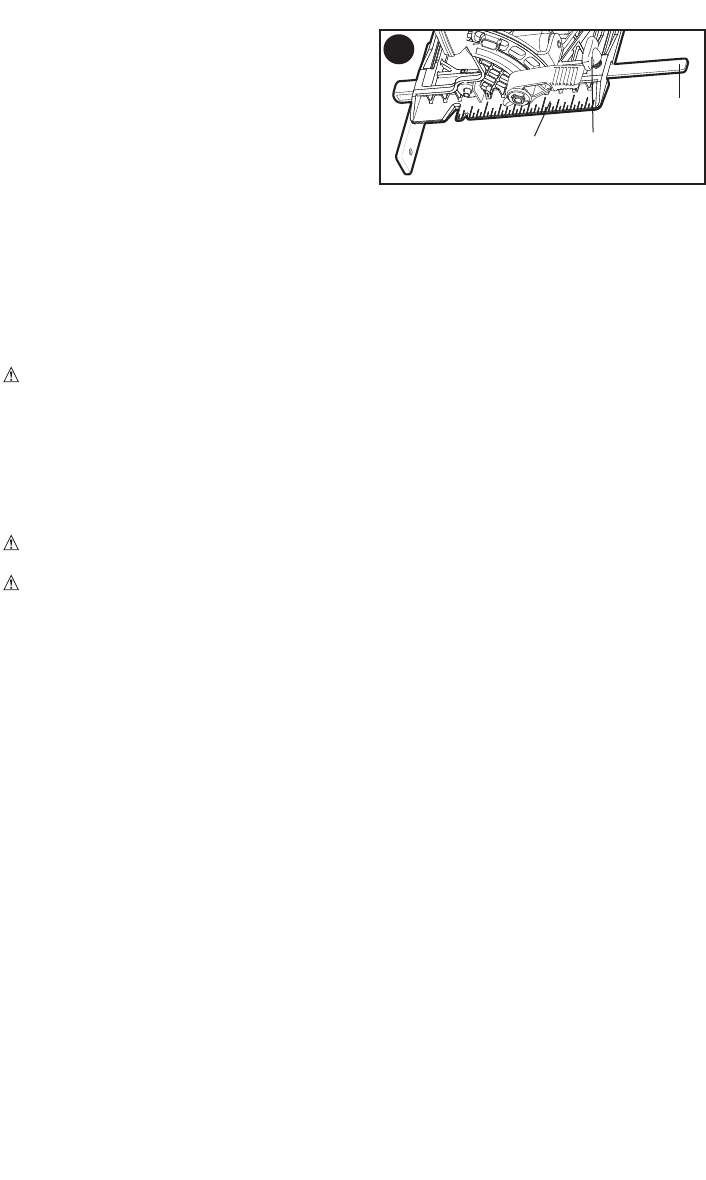
1111
ATTACHING AND REMOVING A RIP FENCE (FIGURE N)
A rip fence
(not included - available at extra
cost
is used to saw in a straight line parallel to
the edge of the workpiece.
ATTACHING
• Insert the rip fence (20) through the
openings in the shoe (5).
• Slide the rip fence into the desired position.
• Screw in locking knob (21) and tighten.
REMOVING
• Loosen the locking knob (21).
• Pull the rip fence out of the tool.
NOTE: If you do not have a proper fitting fence, use a straight edge guide in contact
with the edge of the shoe to improve accuracy of cut and reduce the possibility of
binding and kickback.
OPERATION
To reduce the risk of serious personal injury, turn tool off and disconnect tool from power
source before making any adjustments or removing/installing attachments or accessories.
WARNING: IMPORTANT: Always make sure the depth adjustment is securely
tightened before operating saw.
SWITCH
• To operate the tool, depress the trigger switch (1) in figure A. The tool will continue to
run as long as the trigger is depressed.
• To turn the tool off, release the trigger switch (1). There is no provision for locking the
tool on, and the switch should never be locked on by any other means.
SAWING
WARNING: To reduce the risk of personal injury, always hold saw firmly with both
hands on the handles.
WARNING: Never attempt to use this tool by resting it upside down on a work surface
and bringing the material to the tool. Always securely clamp the workpiece and bring the tool
to the workpiece, securely holding the tool with two hands as shown in Figure E.
Place the wider portion of the saw foot plate on that part of the work piece which
is solidly supported, not on the section that will fall off when the cut is made. As
examples, Figure E illustrates the RIGHT way to cut off the end of a board. Always
clamp work. Don’t try to hold short pieces by hand! Remember to support cantilevered
and overhanging material. Use caution when sawing material from below.
Be sure saw is up to full speed before blade contacts material to be cut. Starting saw
with blade against material to be cut or pushed forward into kerf can result in kickback.
Push the saw forward at a speed which allows the blade to cut without laboring.
Hardness and toughness can vary even in the same piece of material, and knotty or
damp sections can put a heavy load on the saw. When this happens, push the saw
more slowly, but hard enough to keep working without much decrease in speed.
Forcing the saw can cause rough cuts, inaccuracy, kickback, and over-heating of the
motor. Should your cut begin to go off the line, don’t try to force it back on. Release the
switch and allow blade to come to a complete stop. Then you can withdraw the saw,
sight anew, and start a new cut slightly inside the wrong one. In any event, withdraw
the saw if you must shift the cut. Forcing a correction inside the cut can stall the saw
and lead to kickback.
IF SAW STALLS, RELEASE THE TRIGGER AND BACK THE SAW UNTIL IT IS
LOOSE. BE SURE BLADE IS STRAIGHT IN THE CUT AND CLEAR OF THE
CUTTING EDGE BEFORE RESTARTING.
As you finish a cut, release the trigger and allow the blade to stop before lifting the
saw from the work. As you lift the saw, the spring tensioned telescoping guard will
automatically close under the blade. Remember the blade is exposed until this occurs.
Never reach under the work for any reason. When you have to retract the telescoping
guard manually (as is necessary for starting pocket cuts) always use the retracting lever.
NOTE: When cutting thin strips, be careful to ensure that small cutoff pieces don’t
hang up on inside of lower guard.
N
20
5
21


















